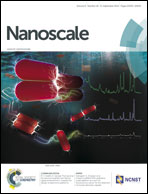Novel behaviors of multiferroic properties in Na-Doped BiFeO3 nanoparticles†
Abstract
Highly aliovalent Na1+ ions were selected as the dopant to substitute Bi3+ ions in BiFeO3 (BFO) and Bi1−xNaxFeO3 (x = 0, 0.01, 0.03, 0.05) nanoparticles prepared via a facile sol–gel method. Weak ferromagnetism and an obvious exchange bias (EB) phenomenon without field cooling were observed in the samples. To establish the presence of EB in the nanoparticles, training effect (TE) data were analyzed using Binek's model. Moreover, with the increase in Na1+ content, the band gap was decreased, while interestingly, the leakage current density was significantly reduced and the smallest leakage current density (∼10−7 A cm−2) was observed for the 3% Na-doped BFO. The electrical conduction mechanism of samples was investigated by plotting log J versus log E. Oxygen vacancies decreased with the increase of Na content analyzed through X-ray photoelectron spectroscopy (XPS) measurements. To further explain the decrease of band gap and leakage current density with the increase of Na content, the interplay of oxygen vacancies and holes was analyzed and a phenomenological qualitative model based on the electronic energy band proposed.


 Please wait while we load your content...
Please wait while we load your content...